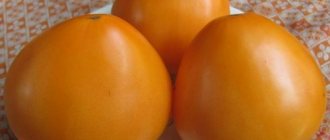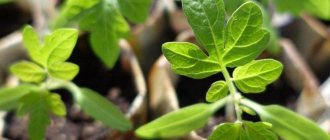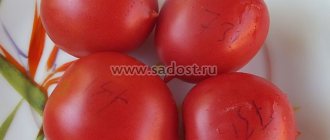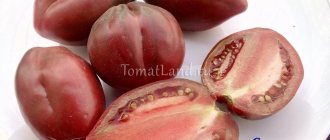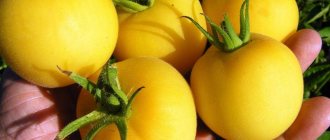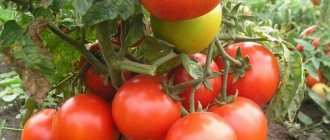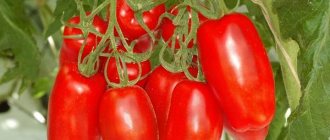Tomato Pride of the Feast F1 is the best decoration for the holiday table. Either serve it whole, or in slices and aromatic salads. Belongs to everyone’s favorite group – pink beef tomatoes.
| Height | Landing location | Ripening time | Fruit color | Fruit size | Origin | Fruit shape |
| Tall | Greenhouse, Open ground | Mid-season | Pink | Large | Hybrid | Flat-round |
Description and characteristics of the variety
Tomato Pride of the Feast is an indeterminate tall hybrid, shoots grow up to 2 m and require pinching and shaping. Leave up to 8-9 fruiting clusters. On each branch, 3 to 5 giant tomatoes are formed.
Ripening time is average - 110-125 days from germination. The first fruitful clusters are formed behind the 9th leaf.
Tomato Pride of the Feast from the company Partner grows in greenhouses and open beds. Loves fertile soil, but well aerated. It is distinguished by the strength of its shoots, which do not break or crack under the weight of giants.
The average weight of tomatoes is 300 g, the largest beefs reach 500 g.
The pulp is fleshy, the combination of sweetness and sourness is ideal. Many small chambers with seeds. High levels of sugar and solids, silicon and carotenoids.
Tomatoes are used for salads, as well as for juices, sauces, and pastes.
Features of agricultural technology
There are no difficulties in cultivating and caring for hybrid tomatoes, but some recommendations should be followed.
- Before planting, prepare the soil by adding organic fertilizers. How to apply fertilizing, read this article.
- The seedlings are transferred to a greenhouse or an open bed when they reach 65 days of age (after about 40 days you can pick the first fruits).
- For 1 sq. m. plant 3, at least 4 plants (scheme 80x50).
- Ideally, grow Pride of the Feast in 2 stems. Some experienced gardeners grow one or three trunks, and recommend that others do so, finding this an advantage in terms of yield.
- It is necessary to pinch the top of the tomato approximately 1.5 months before the expected harvest.
Tomatoes the pride of the feast description of variety photo reviews
Tomato Pride of the Feast is one of the newest tomato hybrids, bred by the Moscow Region agricultural sector. The variety has already gained respect from summer residents, but it is still interesting to study its characteristics.
Description of the tomato variety Pride of the Feast
This variety is represented by tall, continuously growing tomatoes, capable of reaching 2 m in height.
It has powerful, strong branches and a central trunk; it does not break even under the weight of massive fruits, although most often the stems are still tied up and attached to supports.
The racemes, on which flowers and fruits subsequently appear, develop above the 9th leaf and then go every 2 leaves. Each brush can produce 3–5 fruit ovaries.
Description of the tomato Pride of the Feast indicates that the variety is ideal for growing in the middle zone, is resistant to diseases and pests, and requires minimal care. In terms of ripening time, the variety belongs to the early variety - it is customary to plant seeds in February, and the harvest from the stems is harvested in just 3 - 3.5 months.
Description of fruits
The fruits of the Pride of the Feast variety have a flat-round shape and faint ribbing. During ripening, their skin retains a pink color with a green spot around the stalk; fully ripe tomatoes are entirely raspberry, dark pink.
A striking feature of tomatoes of this variety is their large size and significant weight. On average, one fruit weighs at least 300 g, and with proper cultivation, fruits can reach 500 g each.
The pulp of tomatoes is dense and juicy, without voids, with small seeds in small seed chambers. Tomatoes ripen simultaneously on the lower and upper parts of the stem, so it is especially convenient to collect them.
Characteristics of the tomato variety Pride of the Feast
In order to make a decision about planting a tomato variety in your dacha, it is not enough to focus only on the taste of the fruit. You need to know what qualities the Pride of Feast f1 tomato has, whether it is difficult to grow it in specific conditions, and how profitable it is to plant it.
Productivity
The variety Pride of the Feast refers to early-ripening tomatoes, since the fruits ripen within 90 or 100 days after planting. The yield is estimated to be high - 1 sq. m of seedlings yields from 17 to 19 kg of tomatoes, subject to proper care. At the same time, one bush produces 5–6 kg of fruit.
Area of application of fruits
Since the pride of the feast are red-pink tomatoes, they are not suitable for canning and pickling; for such purposes, it is customary to use dark red tomatoes.
However, the variety is ideal for salads, casseroles and other fresh consumption options. Tomatoes of this variety are well transported, so they are suitable for growing for sale.
You can also make healthy juice from juicy fruits.
Resistance to diseases and pests
Characteristics and description of the Pride of the Feast tomato claim that it is a highly resistant variety to typical pests and diseases. Health problems with the plant rarely occur. In particular, the tomato almost does not suffer from rot, late blight, brown spot and tomato mosaic - all these diseases are typical for tomato crops.
However, proper care requires regular preventive inspection of seedlings. When identifying diseases and pests, tomatoes must be treated with Bordeaux mixture, calcium nitrate or copper sulfate. The listed products are sprayed on the seedlings and also added to the water for irrigation.
However, treatment of the plant at the first signs of the appearance of diseases must be carried out promptly - without waiting for the condition of healthy fruits to deteriorate.
Advantages and disadvantages of the variety
The Pride of the Feast variety owes its popularity to its own merits. Namely, the advantages of large red-pink tomatoes include:
- Uniform ripening. All tomatoes on the stem take on a crimson color and ripen at the same time, the top ones on par with the bottom ones. This makes harvesting especially convenient.
- Fleshy, large size, juicy fruits. Tomatoes are ideal for fresh consumption, they can decorate any table, and their taste qualities are rated very highly.
- Early ripening and rapid ripening. It is customary to plant tomato seedlings of this variety in February, and in order to ripen, the fruits require only 90 - 100 days. Thus, already at the very beginning of summer you can grow beautiful, tasty tomatoes in a greenhouse.
- Good transportability. The skin of tomatoes does not crack, they can be stored for quite a long time, so they can be sold, including for commercial purposes, and not just consumed for your own pleasure.
As for the shortcomings, two points can be attributed to them.
- Pride of the Feast tomatoes are not suitable for canning. They can only be consumed fresh, which somewhat narrows the range of applications.
- In the middle zone and northern regions, the variety can only be grown in a greenhouse - Pride of the feast loves high temperatures. Tomatoes are planted in an open bed only in the southern regions.
Despite these disadvantages, the Pride of the Feast tomato variety still remains extremely attractive to gardeners. Caring for tomatoes is very easy, and they produce generous and tasty harvests.
Features of planting and caring for tomatoes
The Pride of the Feast variety is not the most capricious in terms of growing conditions. Even novice gardeners can handle it, but, of course, you need to know the basic rules for caring for seedlings.
Before planting a variety, you must first select the right soil. Seedlings grow well in neutral acidic, fertile, oxygenated soil. It is best to grow tomatoes in a greenhouse, since they are extremely heat-loving and in most Russian regions they simply will not survive in a garden bed.
For planting, purchase young seedlings approximately 65 days old or sow the seeds yourself in closed ground - this must be done in February. When the seeds sprout, the tomatoes are planted according to the following scheme.
- For 1 sq. m. place 2 or 3 tomatoes, forming a small bush, the soil is mulched with straw or hay.
- The distance between individual bushes should be at least 80 cm, and between rows of tomatoes - half a meter.
- Despite the fact that the Pride of the Feast is famous for its strong and thick stems, tomatoes are tied to trellises or supports.
- Tomatoes are usually formed into 2 stems, but formation into 1 stem is also allowed - then the fruits will grow especially large and heavy.
You need to control not only the growth of stepsons, but also the number of inflorescences on the ovaries - the more of them, the smaller the tomatoes will grow. The optimal number of inflorescences is 4–5 on each ovary, and to obtain especially large fruits it is recommended to leave no more than 3 flowers. As the tomatoes ripen, it is necessary to remove the leaves growing from the bottom of the stem.
Pride of the Feast tomatoes are sensitive to watering and ventilation regimes.
- It is necessary to water the seedlings weekly, 1 or 2 times depending on the rate of drying of the soil, very generously. In this case, you need to add water to the root twice a day - in the morning and in the evening. During the period of fruit ripening, it is recommended to increase watering to 3–4 times a week.
- Also, tomatoes in a greenhouse need constant ventilation - fresh air must be let in every day.
- As the inevitable weeds grow, the ground around the tomatoes is weeded and loosened.
Source: https://room46.ru/tomaty-gordost-zastolja-opisanie-sorta-foto-otzyvy/
Transplanting seedlings
At the age of 60 days, tomato seedlings Pride of the Feast are transferred to open ground. This period occurs at the beginning of May. Apply dolomite flour or other mineral fertilizers to the area first.
It is necessary to maintain the optimal planting density - 3-4 bushes per 1 m². The recommended pattern is 80x50 cm. Bushes should be formed into 1-2 stems. Mulch the plant with hay or straw. As soon as the tomatoes take root in their new location, you can tie them to supports.
You need to pay close attention to the formation of the bush. Remove stepchildren in a timely manner. They are absolutely useless for the crop: they take away moisture and essential nutrients.
You need to control not only the appearance of stepsons, but also the resulting inflorescences: the more of them, the smaller the tomatoes will be. The permissible quantity is 4-5 flowers on each brush. If you want to get large fruits, it is better to stop at 3.
Growing and care
Seeds can be planted for seedlings as early as the 20th of February. It is better to soak them first. Germination rate is almost 100%. The seedlings hatch in 4-8 days.
In the phase of 2 true leaves, it is necessary to pick individual pots (for example, peat). The procedure is necessary for better development of the root system and acceleration of seedling growth.
During the growth period, in addition to watering, young plants can be fed. I used Zdraven Turbo fertilizer for tomatoes.
The grown seedlings are transferred to a permanent place at the age of 60-65 days (in early May). I advise you to first add mineral fertilizers and dolomite flour to the garden bed. The optimal planting density is no more than 3 plants per 1 m2 (diagram: 80x50cm).
Each bush should be formed into 1-2 stems (the remaining stepsons must be removed in a timely manner). After the plants have settled into their new location, tie them to reliable supports.
Maintenance is standard and boils down to regular, abundant watering at the roots 1-2 times a week with warm, settled water in the morning or evening, loosening the top soil layer (it is necessary to break up the earthen crusts), and weeding to remove weeds. During the period of fruit formation, the intensity of watering can be further increased.
If you have previously filled the bed with fertilizers, then you do not need to feed the plants. If not, then apply 1 fertilizing 2 weeks after planting the seedlings. Use mullein solution or urea. Subsequently, the bushes are fed during flowering and fruiting with potassium-phosphorus mineral fertilizers.
With proper care, you can get up to 17-19 kg of fruit from 1 m2 per season.
Hello! I’ve completely abandoned my blog, there’s so much to do, there’s not enough time in the day. But the tomatoes Pride of the feast made me write a few flattering words))
All the tomatoes in my greenhouse have signs, and the tomatoes from the Partner are no exception.
Pride of the feast
I chose an extremely unfortunate place for planting, but there’s nothing I can do, all the important tomatoes from Partner and Aelita are at the end of the greenhouse, when the plants were small, it seemed like there was a lot of space for them, but when they started to grow - dear mother! Jungle!
And in this jungle I saw a giant tomato leaning right against the wall - the pride of the feast, two fruits in the cluster.
The pride of the feast Unfortunately, I couldn’t take a better photo; I could barely get through to the wall, and I’m afraid to touch it in case it falls off.
The pride of the feast The rest of the fruits are much more modest so far, but these are the top clusters.
Pride of the feast
I water the tomatoes once a week, didn’t feed them anything serious, and treated them twice with Ordan against late blight.
They grow on their own, the only thing is that I removed the lower leaves and several stepsons. The plants are already large, reaching the ceiling, and will need to be pinched soon.
Thank you for your attention! See you again!
A large-fruited, handsome tomato that evokes admiration and envious sighs from neighbors in the garden - the pride of the feast. You will learn all the details about its features and advantages, as well as advice from experienced gardeners, from the description in the article.
Harvesting
Tomatoes are collected from the bushes when they are already brightly colored. Usually this does not take much time, the tomatoes are well separated from the bush. It is not advisable to pick one-sided and unripe tomatoes. If the bush accidentally breaks or for some other reason it was necessary to pick green fruits, then they are ripened in a sunny place, but not in direct rays. Typically, green tomatoes turn red in 7-10 days, and lopsided ones in 2-3 days.
Advantages and disadvantages
Pride of the Feast is famous for its positive qualities and has more than once won the hearts of gardeners. Its advantages include:
- High yield;
- Precocity;
- Early planting period and early emergence of seedlings;
- Taste characteristics;
- Versatility;
- Unpretentiousness in cultivation;
- Disease resistance.
The variety has one drawback - it is heat-loving.
Competition photos of the hybrid Pride of the Feast F1
The first competition photo of the hybrid Pride of the Feast F1 and the first ripe tomato of this hybrid 08/08/2017. The first ripe hybrid Pride of the Feast F1 on the scales. 08.08.2017.
Hello, friends! I will participate in the competition with photographs and a story about the hybrid “Pride of the Feast” F1.
The sowing campaign began on February 25, 2021. The hybrid “Pride of the Feast F1” showed 100% germination. I soaked them in regular water and snow water. One seed was slightly behind the rest, i.e. a loop appeared from the ground on the 4th day, and for most on the 3rd. But these, I think, are the little things in life). The seedlings were grown in soil consisting of 100% high peat, pH 5.5 - 6.5. During the growth period, it was fed several times with Zdraven turbo fertilizer for tomatoes.
This is what the seedlings of the hybrid “Pride of the Feast F1” looked like at 3 weeks.
Hybrid seedlings Pride of the feast F1 at 3 weeks. 03/18/2017
As the seedlings grew, the dates for planting them in the greenhouse were pushed back and pushed back. Because This is my first year with a greenhouse, so I was guided by the words of my neighbors who plant tomato seedlings in the greenhouse at the end of April - beginning of May. Thus, my seedlings would be 60 days old at the time of planting. As expected for this hybrid. But due to the abnormally cold spring, I was able to plant it only on May 10th. On this date, my seedlings looked pale, both literally and figuratively. Severely overgrown and exhausted in a small volume of soil (about 500 ml.). Next, I made the mistake of planting overgrown hybrids without deepening them. Now I think that I should have planted them lying down, removing a couple or three leaves. Another mistake is that I made 3 narrow beds in a greenhouse, 3 meters wide. Two on the sides and one in the middle. By doing this, I deprived myself and you, dear friends, of full-length photographs of the bush, because... I had nowhere to go to photograph the bush. And it's a shame. But that's history. I will work on the mistakes next season.
By the time the seedlings were planted, dolomite flour and mineral fertilizers (together with molybdic and boric acid) were added to the bed. And the seedlings began to transform before our eyes, changing the color of the leaves from pale green to dark green. Formed strictly into one stem. Then the abnormally low summer temperatures did their job, and the first cluster did not form on all the bushes. There was no mood, there was nothing to photograph either. The second brushes also did not tie completely. Joy came to me only in the month of August, when the first tomato ripened on the 2nd bunch. His photographs are presented above. I completed the bushes around the end of July, because... they were already resting on the roof (about 2 meters high).
Tomatoes rest against the roof of the greenhouse. 09.09.2017.
And at the end of August, the hybrid Pride of the Feast F1 began to produce so many beautiful, even tomatoes that I was very pleasantly surprised. I harvested buckets from this hybrid.
Partial harvest of the hybrid Pride of the Feast F1. 08/27/2017
The tomatoes of the hybrid Pride of the Feast F1 are singing. 08/24/2017. And next to it is the hybrid Velikosvetsky F1. And this is the second contestant) Another giant tomato Pride of the feast. 09/10/2017
Hybrid Pride of the Feast F1 on the scales in section. 09.10.2017. Hybrid Pride of the Feast F1 with brothers (brothers weighing 300 grams each).09/10/2017. Friends! Hybrid Pride of the Feast F1 deserves to be grown. Even in a difficult summer, I produced an excellent harvest of delicious tomatoes!
I am a small specimen of the hybrid Pride of the Feast F1. 08/27/2017. Weight is approximately 500 grams. Out of competition.
Reviews from those who have already planted Pride of Feast
Inga, Vologda region says: “The most favorite variety. There are no problems with landing. All plants sprout quickly and grow wonderfully. The first tomatoes appear early, and already in mid-summer we make salads from fresh tomatoes. Tomatoes have a wide variety of uses, as they are suitable for everything.”
Anna supports: “The pride of the Feast will become the pride of your garden. I have never had such a large harvest before. The tomatoes grew beautiful and red. The taste is tender and juicy.”
Tomato Pride of Feast: variety characteristics, description, reviews, yield
The tomato variety “Pride of the Feast” is distinguished by its juiciness and its large size. He will sing early and quickly enough. The variety belongs to the greenhouse representatives of tomatoes. Pride of the Table is used for salads, tomato juices and winter preparations.
Characteristics and description of the variety
The variety is characterized by early planting in the ground, as the seedlings actively grow in a short period of time. The height of the bush reaches 1.8 m. It is recommended to form the plant into one or maximum two stems. Ripe fruits weigh up to 400 g and have fleshy pulp. The skin is thin but durable and protects the fruit from dents. Tomatoes are round in shape and bright red in color.
The hybrid is resistant to tomato mosaic, rot, and spotting. The variety's yield is good; 20 kg of tomatoes grow from one square meter. Tomatoes are formed in spreading clusters of 3-6 fruits on one branch. Need a garter.
The pride of the feast is heat-loving tomatoes; it is not advisable to plant them outside in the central part of the country, they are afraid of frost. Maximum yield is achieved during greenhouse cultivation.
Features of cultivation
Sowing of seedlings is carried out at the end of February. If the tomatoes were previously grown in a greenhouse, you can take the soil from there. For those who are planting tomato seedlings for the first time, peat tablets are perfect.
They have a rich mineral composition and are specifically designed for growing young plants.
Peat tablets have a low cost (about 8-14 rubles per piece) and are sold in gardening products.
Once the tablets are at home, they are soaked in cool water and left for 20 minutes to swell. Each tablet is intended for one plant. When the tablets have increased several times in volume and the peat has become moist, you can begin planting the seeds.
The seeds are pre-washed with a weak soda solution for disinfection. Then, one seed at a time is planted in peat to a depth of no more than 1 centimeter, and the soil is sprayed with water. This is what you do with each tablet.
When all the seedlings are completely planted, the tablets are placed in a small tray and covered with cellophane film on top. Place the seedlings closer to the sun and monitor the soil moisture daily.
If it dries out, the soil is moistened and covered again with film.
Important! An excess of water in the soil has a detrimental effect on the embryo, so there is no need to over-water it, just moisten the soil.
A week later the first shoots will emerge. This means that the seedlings have taken root and are doing well. They begin to gradually open the film, allow the seedlings to breathe room air and get used to the environment.
In a month the sprouts will grow noticeably. They need to be transplanted into larger containers. Peat tablets are transferred directly into a glass with prepared soil. You can also purchase special cups with a removable bottom.
They are suitable for reusable use, and during transplantation into the greenhouse they will be very convenient to use - the bottom can be easily removed and you can easily pull out the roots of the plant. After diving, the seedlings are watered using nitrogenous or phosphate fertilizers.
They intensively nourish the tomato root, and the plant will quickly recover after transplantation.
You may be interested in:
Picking slows down the intensive growth of the plant, but not for long. By the beginning of May, the tomatoes are ready to be transplanted into the greenhouse.
By this time the bushes will be tall and full of vigor; they will be cramped in the cups. First, the tomatoes are allowed to get used to the greenhouse temperature.
You can put the seedlings in the greenhouse a few days before planting and keep them for a couple of days. This time is enough for the plants to get used to the temperature and climate.
Attention! The soil in the greenhouse must be prepared a week before the intended planting. To begin with, they dig it up and level it. If the soil is rich in vitamins and minerals, then there is no need to fertilize it. In other cases, chicken droppings or cow manure are introduced into the ground, carefully distributed around the entire perimeter and dug up again. You can add humus or river sand. Tomatoes grow well in porous soil.
Holes are made in the ground and tomatoes are planted, immersing only the root system in the hole. Between each plant there should be a distance of at least 50 cm from the neighboring one. Tomatoes grow quickly, their branches will intertwine and interfere with each other. When the transplanting is complete, all seedlings must be watered. There is no need to open the windows and doors in the greenhouse after transplanting.
By mid-July, the tomatoes on the bushes begin to increase in size and ripen. During the fruiting period, tomato bushes require additional care. Many gardeners increase watering frequency at this time and introduce organic matter as a top dressing. Then the tomatoes will be tastier and larger in size.
Harvesting
Tomatoes are collected from the bushes when they are already brightly colored. Usually this does not take much time, the tomatoes are well separated from the bush. It is not advisable to pick one-sided and unripe tomatoes.
If the bush accidentally breaks or for some other reason it was necessary to pick green fruits, then they are ripened in a sunny place, but not in direct rays.
Typically, green tomatoes turn red in 7-10 days, and lopsided ones in 2-3 days.
Advantages and disadvantages
Pride of the Feast is famous for its positive qualities and has more than once won the hearts of gardeners. Its advantages include:
- High yield;
- Precocity;
- Early planting period and early emergence of seedlings;
- Taste characteristics;
- Versatility;
- Unpretentiousness in cultivation;
- Disease resistance.
The variety has one drawback - it is heat-loving.
Reviews from those who have already planted Pride of Feast
Inga, Vologda region says: “The most favorite variety. There are no problems with landing. All plants sprout quickly and grow wonderfully. The first tomatoes appear early, and already in mid-summer we make salads from fresh tomatoes. Tomatoes have a wide variety of uses, as they are suitable for everything.”
Anna supports: “The pride of the Feast will become the pride of your garden. I have never had such a large harvest before. The tomatoes grew beautiful and red. The taste is tender and juicy.”
Source: https://sveklon.ru/tomat-gordost-zastolya
Conclusion
The Pride of the Feast tomato is a variety that requires minimal care and is suitable for growing in almost any region. But at the same time, the plant bears large, nutritious, very tasty fruits that ripen in early summer.
Reviews
Petrova Daria Ivanovna, 37 years old, Ryazan
Pride of the Table is one of the best tomato varieties I have ever grown. The seedlings are very easy to care for; the variety is practically not affected by pests and diseases. And the fruits of the Pride of the Feast are a sight to behold - large, beautiful, with smooth, durable skin. I really like the juiciness of tomatoes; they are ideal for salads.
Avdeeva Olga Nikolaevna, 42 years old, Tula
Two years ago I read reviews about the Pride of Feast tomato and purchased the seeds for myself for the first time. I have never had such a high-quality harvest in my greenhouse - the tomatoes all ripened large and heavy, and ripened at the same time. After harvesting, I was pleased with the taste - the pulp is very juicy, the tomatoes are wonderfully refreshing.
Kozlov Valery Andreevich, 38 years old, Volgograd
Reviews of the Pride of the Feast tomatoes are mostly positive, and I can only join them. I love this variety more than all the others, because the tomatoes ripen quickly, delight with their bright taste and large size, and there are no problems with care.
Source: https://fermilon.ru/sad-i-ogorod/ovoshhi/tomat-gordost-zastolya.html
